Production of Tiger Shrimp
Production of Tiger Shrimp
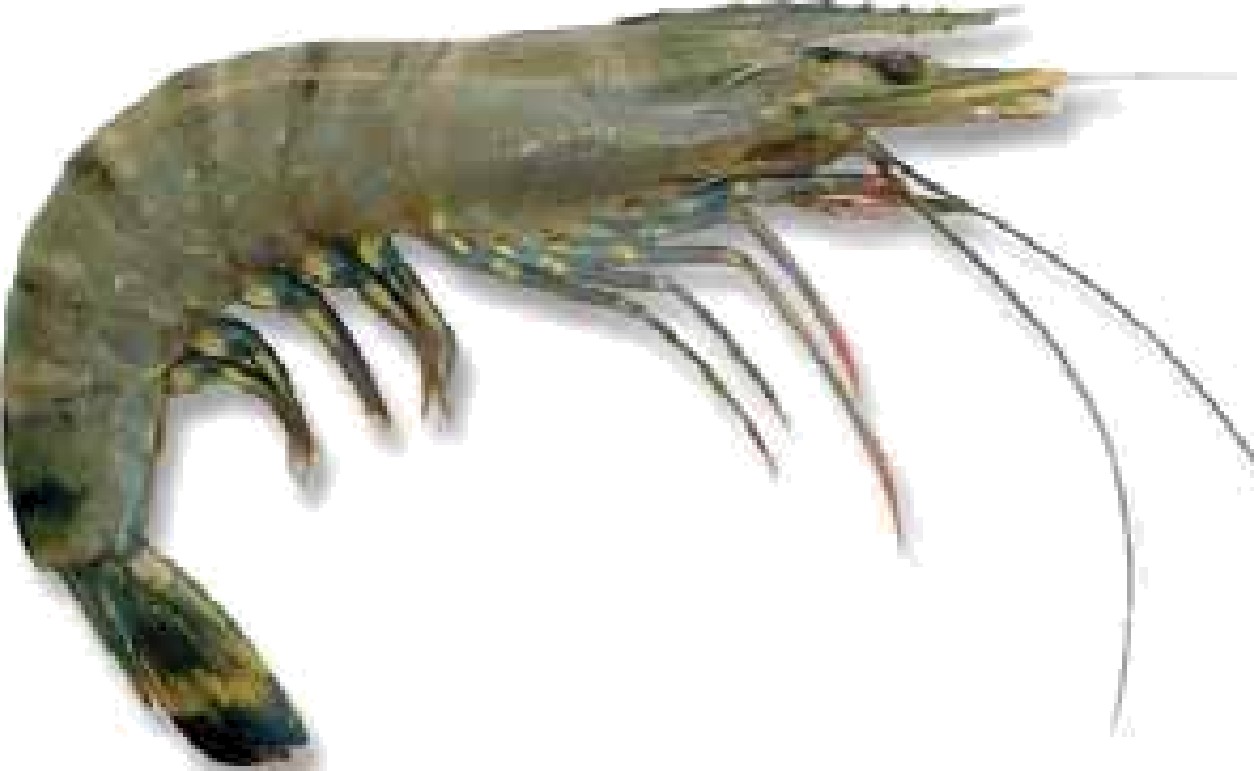 The tiger shrimp, Penaeus monodon is one of the fastest growing species among cultured shrimps.
The tiger shrimp, Penaeus monodon is one of the fastest growing species among cultured shrimps.
The species is euryhaline and can even tolerate near freshwater conditions. In India, shrimp culture has been followed as a traditional activity since ages. However, it made a phenomenal growth during 1990’s due to the adoption of scientific practices.
Farming of tiger shrimp is generally practiced in the tidal flats and other areas adjacent to the coastal waters. The steady demand in the global market and high economic return has attracted farmers to adopt tiger shrimp culture.
Seed Production
The hatcheries in India follow the Galveston system’ (Clear water system) with physically separated facilities for quarantine, broodstock maturation, spawning, hatching, larval rearing, post-larval rearing, indoor & outdoor algal culture and artemia hatching. The collection, holding, transportation, maturation and spawning of the broodstock is done as carefully as possible to minimize stress, injury, infection and mortality. Maintenance of proper water quality, aeration and feeding are the important factors in hatchery management. The water taken to the hatchery and that discharged-out should be of stipulated quality and free of pathogens.
Procurement of broodstock
The availability of good quality broodstock is the primary requirement for the successful seed production. Healthy and disease free female weighing 150-200 g and male weighing100-120 g are collected from the wild (sea), kept individually and transported to the hatchery in oxygenated spawner bags filled with filtered, clean sea water already sterilized using UV light or ozone. Care is taken to minimize handling. Place a rubber tube on the rostrum of the animal to avoid puncturing of the bag. The polyethylene bag, used for transportation of broodstock should not be re-used.
On reaching the hatchery, the brooder is slowly acclimatised and disinfected in 100 ppm formalin solution for 30 seconds. The disinfected female is tagged to identify individually and kept in the quarantine area which is separated from other units of the hatchery. The equipment and accessories (tank, bucket, air stone, net etc.) are disinfected carefully with 100 ppm chlorine before and after every use.
A gross examination of each brooder is done to ensure that it has a clean body and gills, bright colouration, intact appendages and undamaged eyes. Shrimp with black melanised lesions, large areas of white muscle, or bright red in colour is discarded. A small piece from a pleopod is cut-off and sent for PCR test for ensuring the health status of the animal.
Water quality management
The procedure is similar as explained for the milkfish.
Maturation
The male and female broodstock are held separately in dark-coloured and smooth-sided tank of 10 t capacity with 1.2 m height at a density of 2-4 no./m2. They are fed 3-4 times daily @ 6% of the body weight with fresh polychaete worm, squid, mussel, clam and enriched adult artemia. Alternatively, it can also be fed @ 2% of the body weight with high quality formulated broodstock feed (50% protein and 10% lipid). The water level inside the tank is maintained at 70 cm with mild aeration and 100% water exchange in alternate days with filtered water having a salinity of 28-35 ppt. Maintenance of constant temperature (28-29°C) and pH (7.5-8.5) is critical for the successful maturation of the brooder.
Broodstock tank
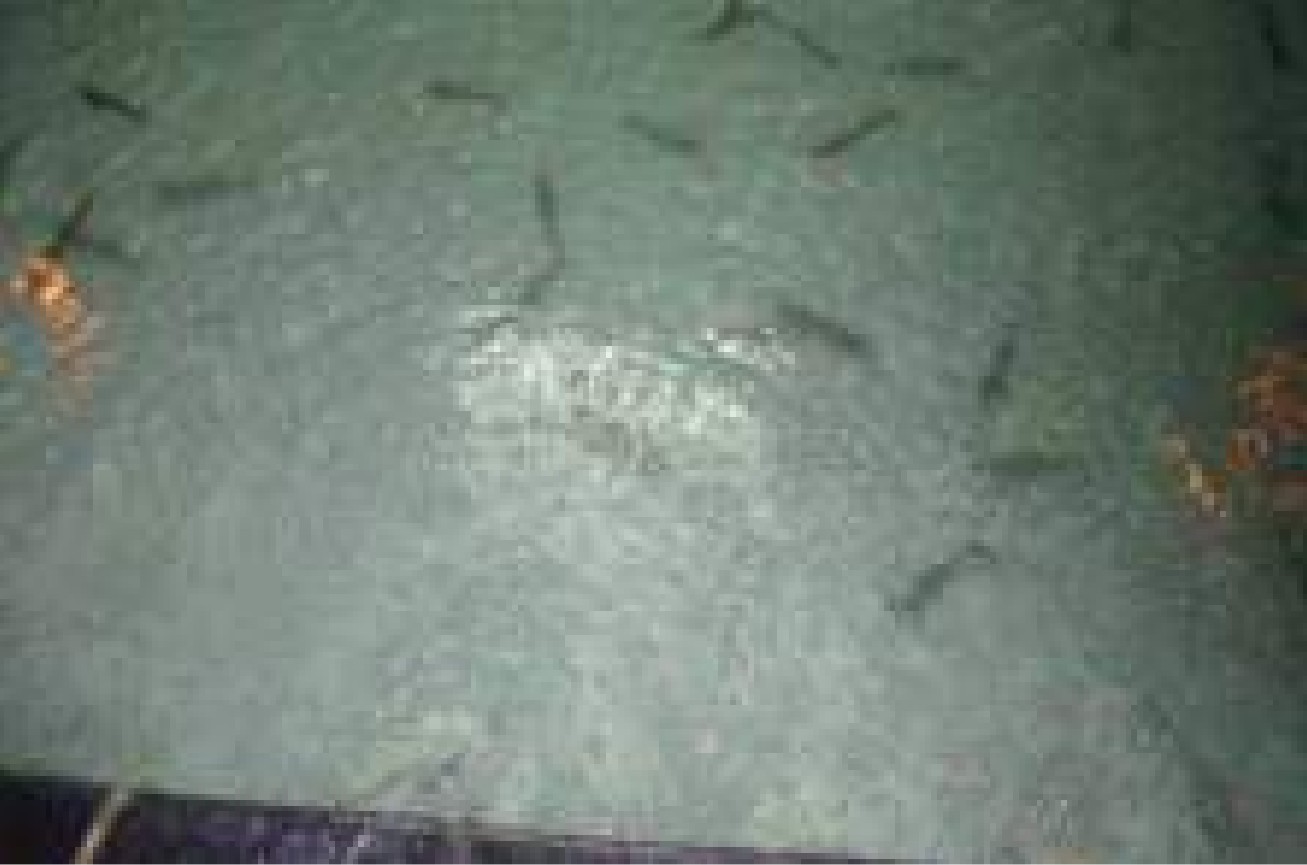
Eyestalk ablation
The female is given sufficient time to recover from transportation stress before eyestalk ablation. In pre-moult or post-moult stages, duration of one week is given to enable the animal to withstand the ablation stress. During inter-moult period, one of the eyes of the female is cut-off with hot pincers or tied with string or cut-off with scissors or a sharp knife. The area around the ablated eye is disinfected with povidone iodine followed by bath in a tank containing 10 ppm oxytetracyclin for an hour and the animal is returned back to the maturation tank. After 3 days of ablation, the water level in the tank is reduced to 50 cm. An ablated female usually takes 3-7 days for spawning.
Courtship and mating behaviour
Mature hard-shelled males are released to the tank where the eye stalk ablated females are kept (male to female ratio is 1:2). Tiger shrimp has a closed thelycum, hence insemination is possible only immediately after each moulting of the female. Male swims parallel to and positions itself below the female and bends its body in such a way that both are in close contact ventrally. Courtship and mating continue for 1-3 hours. Finally the male turns perpendicular to female and mating usually occurs during night. The lateral plates of thelycum lead to a seminal receptacle where the spermatophores are deposited by the male using the petasma soon after the female has moulted. After mating, the spermatophore can be easily seen externally as vertical, milky white streaks on both sides of the thelycum.
Spawning
The gravid female has dark green, granular ovary having a diamond shaped swelling. Using underwater torch females with spermatophore visible on the thelycum are sourced from the maturation tank in the evening and are transferred to separate FRP spawning tank of 500 l capacity having 300-400 l clean sea water with very mild aeration. Each brooder is individually kept in tank to reduce the risk of horizontal transmission of diseases. The tank is designed to facilitate easy and complete harvesting of egg with minimum damage or loss.
Spawning usually occurs in the late night or early morning. The spent female is immediately shifted back to the maturation tank and any metabolic waste in the spawning tank is siphoned-out. The eggs are collected with a harvest bucket of 100 qm mesh size or siphoned out, washed with filtered and sterilized sea water, disinfected with iodopovidone (50-100 ppm) for 10-60 seconds, rinsed with clean sea water and finally transferred into hatching tank. Fecundity is 3-5 lakh depending on the size of the female. Fertilisation rate is determined by examining some samples of eggs and it is usually found to be more than 90%. In order to ensure good quality seed, each female is allowed to spawn to a maximum of three times only. Records of spawning are maintained to enable traceability. After collecting eggs, the tank is disinfected with 100 ppm formalin for 30 seconds or 50-100 ppm povidone iodine for l -3 minutes. Treflan at a dose of 0.05-0.1 ppm is added to combat fungal infection.
Incubation
Incubation is carried out in an FRP hatching tank of 0.3-1 t capacity, which allows good water circulation, mild aeration and easy harvesting. The eggs are incubated at a density of 4000 no./l in suspension by providing mild aeration with manual mixing of the water until hatching. After spawning, the fertilised egg hatches out into nauplius (first larval stage) within 12-15 hours at 28-320C and 29-34 ppt salinity and the aeration is increased thereafter. The nauplius subsists on its yolk material. In order to harvest the nauplii, the aeration is stopped and the healthy nauplii which are phototactic (attracted and aggregated towards light) are collected by siphoning or scooping. The un-hatched egg and weaker nauplii that remain in the tank are then discarded and the tank is cleaned and disinfected. The harvested nauplii at stage 4 from incubation tank are treated by immersion in 100 ppm formalin for 30 seconds followed by a thorough wash in filtered and sterilized water. The quantity of healthy nauplii is counted to estimate the hatching rate and transferred to the larval rearing tank.
Rearing of larvae
The larval stages are very critical and very sensitive phases of life cycle of the shrimp. Shrimp larva passes through nauplius (6 stages), protozoea (3 stages) and mysis (3 stages) to become post-larva (PL). Metamorphosis from one stage to another takes place followed by a moulting. Flat bottomed circular or rectangular FRP tank of 10 t capacity with continuous aeration facility is usually used for larval rearing. Rectangular tank is space saving and more convenient while circular tank is easy to clean and will ensure better water circulation. The tank is disinfected with 200 ppm sodium hypochlorite solution for 10 hours, washed with freshwater, dried under shade for 24 hours and half-filled with disinfected and filtered sea water.
The nauplii at stage 4 are stocked after acclimatisation at a density of 100 no./l with aeration. The nauplius completes six moults within 36 hours and metamorphoses into protozoea. The larva starts feeding on unicellular algae immediately after nauplius stage. Hence, from the nauplius at stage 6 onwards, the tank is inoculated with unicellular live diatom such as Chaetoceros, Skeletonema and Thalassiosira cells @ 50,000 no./ml of tank water to avoid starvation of metamorphosed protozoea. Feeding with unicellular diatom is continued throughout the zoea and mysis stage and it is subsequently reduced to 10,000 no./ml of tank water on reaching the PL stage. The algae also help in maintaining the water quality by utilizing carbon dioxide and ammonia produced in the tank. Alternatively, Spirulina and encapsulated feed is also given at 3 hours interval. As the protozoea is positively light sensitive, the tank is covered to ensure darkness. The protozoea undergoes 3 sub-stages within 3-6 days.
Healthy protozoea with adequate feeding (indicated by the presence of faecal thread) metamorphoses into mysis which undergoes 3 sub stages and metamorphoses into Post Larva (PL) within 3-5 days. Algal feed is continued as the larvae retains filter feeding habit but partially replaced with artificial diets. Quantity of artificial diet is determined based on the observations of the larval feeding habits and water quality. Overfeeding should be avoided as it may degrade the water quality.
No water exchange is done for the first six days. The water level in the tank is gradually raised until the larva reaches Mysis-1 stage and thereafter water exchange is done daily at 30% until the larvae metamorphose to PL. The nauplius, protozoea and mysis stages of tiger shrimp are completed within 8-10 days at 30°C. In general, the survival rate during the larval rearing is 40-50%.
Rearing of Post-Larvae (PL)
Once the larva metamorphoses to the PL, it is shifted to the outdoor PL rearing tank (Parabolic cement tank of 20 t capacity) or retained in the indoor larval rearing tank (FRP tank of 10 t capacity). The stocking density of PL is 75-100 no./l. Overstocking leads to stress and results in cannibalism. As PL ceases filter feeding and switch over to pick up feeding, it feeds on zooplankton well and so fed with live Artemia nauplii. Decapsulation of Artemia is done to avoid contamination and cyst feeding by the larva. It also ensures hatching efficiency of Artemia. One million PL requires 6 kg of Artemia cyst and the details of daily ration are given in Table below.
Artemia nauplii requirement
| PL stage | Artemia nauplii per ml | Daily frequency |
| 3-6 | 2 no. | Thrice |
| 7-12 | 3 no. | Thrice |
| 13-20 | 3 no. | Once |
From PL7 onwards, Artemia nauplii is gradually replaced with micro-encapsulated feed and egg custard (<500 micrometer size) as the shrimp larva becomes able to consume food materials available at the bottom. When formulated diet is used to supplement the live feed, it is important to feed a small amount of high quality and appropriately sized diet frequently. From PL-13 onwards, as the frequency of feeding with Artemia nauplii is reduced to once daily, artificial feed is given for remaining two times daily @ 50 g/million PL. The quantity of artificial feed may be split into various lots with an interval of 3-4 hours to ensure good water quality. Failure to provide sufficient feed can lead to stress, poor growth, impaired moulting, mortality, cannibalism, deformity and increased levels of epibiont fouling. While procuring and storing feed, it should be ensured that the feed is free from pathogens especially fungi.
Larval rearing
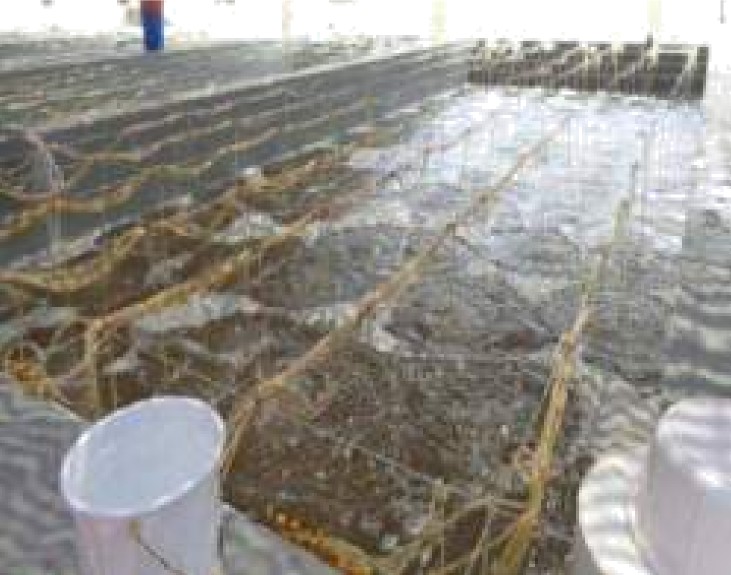
Water exchange is done 50% daily until harvest. Unconsumed feed, faecal matter and other waste materials are daily siphoned out after turning off the aeration. The bottom debris is carefully siphoned-out into a fine mesh net (250 micrometer) to prevent PL from escaping from the tank. The survival rate from larva to PL is 65-75%.
Monitoring
Health assessment of larva, water quality parameters and density and quality of algae are regularly monitored in the morning so that decisions on water exchange, feeding and other management activities could be planned and executed in the day time itself.
Besides, visual inspection of the larva and water in each tank is done 3-4 times daily by taking samples in beaker to monitor the larval stage, health, activity, behaviour and abundance of feed and faeces. The equipment and materials used to harvest the nauplii are washed daily with 30 ppm sodium hypochlorite solution to prevent contamination to subsequent batches. The details of water quality parameters and feeding are recorded and maintained properly. A sample of larvae is sent to the laboratory for detailed microscopic examination of the larval stage, digestion and presence of any disease or physical deformity. A deformity rate of less than 5% is generally considered acceptable. Besides, sample is sent twice for PCR screening during the cycle. Health of the nauplii is also checked by phototaxis.
Monitoring of PL

Algal culture
Algal culture facility consists of indoor and outdoor sections. In the indoor section, pure strain of algae is isolated and cultured in axenic culture media in vessels having sizes ranging from 10 ml test tube to 20 l carbouys. Micro algal culture requires extreme hygiene in the indoor phase to prevent contamination, which includes the use of laboratory grade chemicals, thorough disinfection, filtration of water up to <0.5 micrometer and proper aeration facility. Air conditioning is also necessary to maintain temperature at 22-24°C. The algae thus produced in the indoor section are brought to the outdoor algal tank for mass culture.
After filling the outdoor tank with filtered sea water and fertilised with the nutrient media, it is inoculated with the algae brought from the indoor section. Continuous aeration is provided in the tank to keep the algae in suspension and allowed to multiply for 2 days. Then it is pumped into the larval-rearing tank or the concentrate is harvested through a fine mesh filter net and added to the larval rearing tank to get the cell density of 50,000 cells/ml.
Artemia hatching
In clean cylindro-conical tank, decapsulated artemia cyst is incubated @ 2g/l with continuous vigorous aeration to prevent the cyst from settling. Sufficient light (1000 lux) is also provided to enhance hatching. The nauplii are harvested after 18-24 hours of incubation. Prior to the harvest of artemia, the aeration is turned off. The phototactic nauplii are attracted towards the illuminated translucent bottom of the tank and collected in 100 qm mesh net. The collected nauplii are washed thoroughly in clean running water before feeding.
Harvest and transportation
The seed is harvested and transported at PL15 stage onwards, i.e. 23- 28 days after hatching. The harvest should be with minimum stress to ensure better survival. Seeds are acclimatised to the salinity of the grow- out pond by adding freshwater to the rearing tank. Such salinity adjustments are done only after PL10 stage. Salinity adjustment up to 4 ppt can be done in a day. After draining the water from the tank, PL is harvested using a scoop net and packed in polythene bag with one third water of the desired salinity as explained for the major carps. The stocking density of PL15 during transportation is 500-2500 no./l depending on time and distance. Live Artemia nauplii are added @ 15- 20 no./PL for every 4 hours of transportation. A few granules of washed activated carbon as an adsorbant may also be added to each bag to control ammonia level during long transportation. It is advisable to transport the seed at night when the temperature is low, for reducing stress during transportation.
Pond Farming (zero water exchange)
Site selection and pond construction
Since shrimps are benthic organisms, type of soil is the most critical factor in site selection. The soil should have good water holding capacity and could be shaped into a ball which does not crumble even after considerable handling. Clayey loam soil is preferred while acid sulphate soil is not advisable. Samples of soil is taken from a depth of 1 m and tested for various parameters. The ideal soil quality parameters include 6.5-8 pH, 1.5-2.5% organic carbon and >4 micrometer electrical conductivity. Pond having the size of 0.5-2 ha water spread area with length to width ratio of 2:1 and a depth of 1-1.5 m is ideal. The site with an elevation of 0.2 to 0.5 m above the high tide level allows easy pond preparation and harvesting.
The components of a shrimp farm are water control structures such as dyke, feeder canal, sluice gate and supporting facilities such as water pump, aerator, generator, warehouse, farm house, farm road, effluent treatment system etc. The excavated earth is utilized to construct the peripheral dyke with about 60 cm height above the maximum flood level and 3 m top width and the internal bund with 30 cm freeboard and l m top width. There may be separate inlet and outlet facilities diagonally with sluice gates of 150 cm wide for every one ha water spread area. The water intake point to the reservoir pond is fenced with bamboo poles and net.
Entry of unwanted organism including fish and the escape of stock from the pond is prevented by using wire mesh filter net in the outer side and nylon screen net in the inner side of sluice gate. The mesh size of the nylon screens should be as follows.
- <15 DOC - 600 micrometer
- 15-45 DOC - 1200 micrometer
- >45 DOC - 1800 micrometer
As a part of ensuring bio-security measures and to prevent the entry of birds and animals, the top of the pond is covered by net of 100 mm mesh size and the side is fenced with stiff net of 26 mm mesh size or shade net up to a height of minimum 1.8 m.
Drying and liming
In the case of existing pond, dykes are strengthened by plugging holes and crevices to prevent the leakage of water. Sluice gate is repaired and the farm machineries are serviced and fixed in the desired positions. Draining the pond and exposing to sunlight increase the productivity and help in eliminating unwanted organism. Ploughing the pond bottom to a depth of 15-20 cm helps the release of poisonous gases. The sludge accumulated at the centre of the pond during the previous farming period should be removed.
Sludge removal
In the case of pond having acid sulphate soil, complete drying of pond bottom is not recommended. Zeolite or aluminium silicate at 250 kg/ha is applied to prevent the contact of water with the acid sulphate soil by forming a sediment layer in between. Initial dose of agricultural lime is added to enhance soil pH as below:
4.0-4.5 pH : 1500 kg/ha
4.5-5.5 pH : 1000 kg/ha
5.5-6.5 pH : 700 kg/ha
6.5-7.5 pH : 500 kg/ha
Liming is also required during rain fall at the rate of 250 kg/ha of lime applied over the slope of the dyke, so that it slowly dissolves in water.
Disinfection of pond
Two weeks prior to stocking, water is allowed to enter the pond and is disinfected by chlorination (35-50 ppm) using calcium hypochlorite (30% active chlorine) to destroy all undesirable organisms including microbes and parasites in the soil. The water has to be dechlorinated by exposing to sun or by aeration. The pond water with chlorine is never let-out directly into open water body.
Manuring
Prior to 10-12 days of stocking, the water is fertilized with inorganic fertilizers containing nitrogen and phosphorous @ 40-50 kg/ha to stimulate the growth of diatoms. In low saline water, urea and super phosphate are used in the ratio 2:1 while in high saline water, use of equal quantity of urea and super phosphate is ideal. Application of silicates @ 30 kg/ha also stimulates growth of diatoms.
Water quality requirements
- Temperature : 28-32OC
- DO : >5 ppm
- pH : 7-8.5
- TAN : <0. 1ppm
- Transparency : 25-45 cm
- NO2-N : <0.1ppm
- Salinity : 10-35 ppt
- NO3-N : <10 ppm
- Alkalinity : >200 ppm
- H2S : <0.l ppm
Hardness : 100-150 ppm
Iron : <1 ppm
Stocking
The hatchery produced PCR screened uniform sized healthy seeds (PL-15) are stocked either during morning or evening hours at a density of 6 no./m2 after acclimatisation. Acclimatisation to salinity is done at the hatchery itself.
Acclimatisation of seed
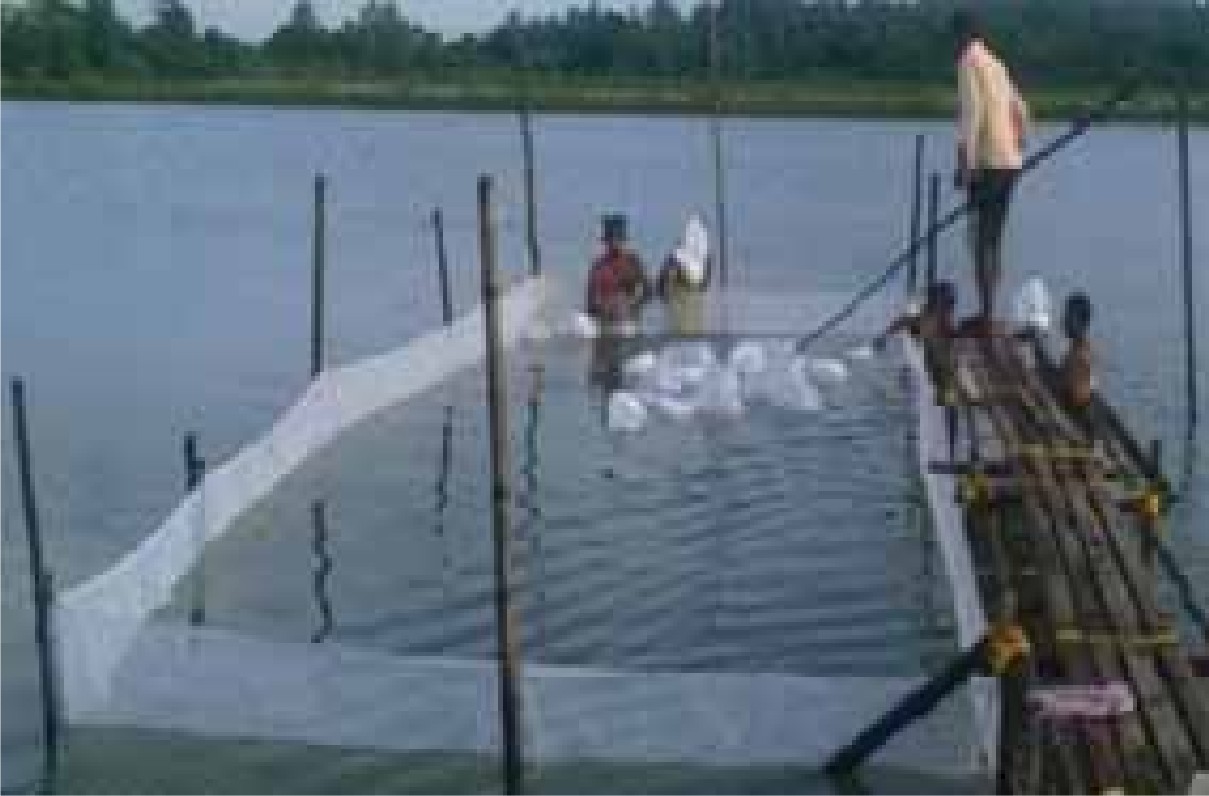
Feeding
The tiger shrimp is fed with a sinking pelletted feed containing 35- 40% protein and 3-5% lipid and having water stability for 3-4 hours. Feeding should be avoided near the drain and aerator. In ponds with sandy bottom, broadcasting is preferred while in those with loamy bottom, tray feeding is better. Check trays are used to monitor the feed consumption and the feeding ration is adjusted accordingly.
Check tray observation
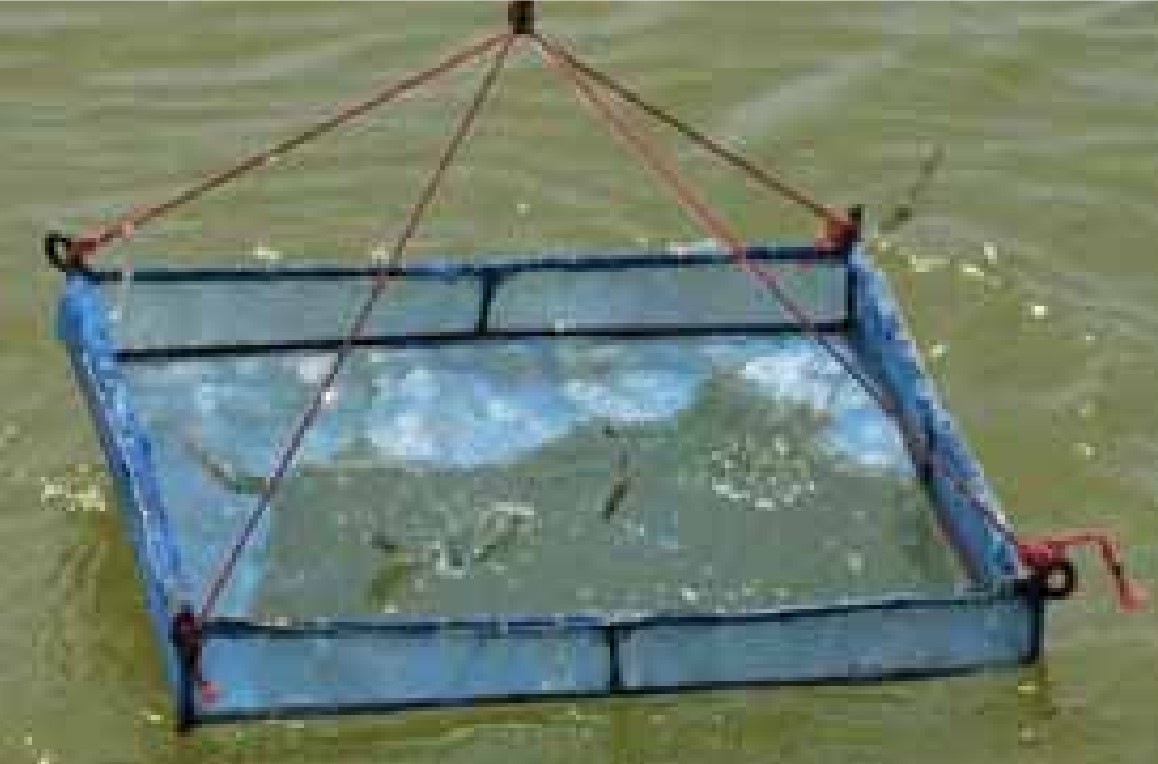
Recommended feeding rate is followed during the first month of culture; later feeding ration is adjusted with the help of check tray analysis. The details of feeding rate are given in Table below.
Feed requirement
| DOC | ABW (g) | Daily feeding rate (% of ABW) | Feeding frequency |
| 1 | 0.02 | 50.0 | 2 |
| 15 | 0.95 | 10.0 | 2 |
| 30 | 2.90 | 8.0 | 3 |
| 45 | 7.00 | 6.4 | 3 |
| 60 | 11.00 | 4.9 | 4 |
| 75 | 16.50 | 3.7 | 4 |
| 90 | 24.30 | 3.0 | 5 |
| 105 | 32.00 | 2.3 | 5 |
| 120 | 35.00 | 2.3 | 5 |
The quantity of feed given is recorded daily. Wet/moist feed should be avoided as far as possible since it could be potential source of pathogen. To assess the growth rate and biomass of stock, sampling with cast net is done biweekly. Analysis of the gut content of the shrimp gives an indication of the feeding conditions. Feed is stored in dry, well ventilated protected places.
Care and monitoring
Replenishment of water is done to compensate evaporation loss. The water drawn to fill the pond should be devoid of toxic gases and other pollutants. Never take water directly from natural open source as it has the risk of containing potential pathogens and their intermediate hosts. Use of filter net having mesh size of 60 micrometer in inlet pipes and sluice gates controls the pathogen and young stages of carrier organisms. The water is disinfected in a reservoir pond by chlorination (35-50 ppm) with calcium hypochlorite prior to filling the culture pond as pathogens like WSSV can survive as free-living form up to seven days.
Left over feed, metabolic waste or sudden death of plankton may lead to the rise of ammonia. As there is no water exchange during the entire culture period, probiotics are applied to maintain water quality at desirable level, initially 3 days before stocking and subsequent doses in every 10 days interval based on the condition of the pond. The water quality is also maintained using aerators @ 1 hp for every 500 kg of biomass. The aerators are placed in such a manner that all of them create circular water movement of water in the same direction and produce only minimum dead space. It accumulates the waste at the centre portion of the pond. The aerators are used only for 6 hours in the first four weeks, which is then increased to 9 hours by 10th week and further to 12 hours until harvest with proper day to day monitoring.
Homemade inoculum made by fermented jaggery (10 kg) and rice bran (40 kg) with yeast powder (500 g) in a barrel with 500 l water for 2 days is applied to pond water once in a week @ 500 l/ha to keep the pond environment healthy. Commercial probiotics are also applied to feed, water and soil whenever required. Mineral mixture, zeolite, ammonia reducer, etc. are also used as per the requirement.
Weekly assessment of shrimp for its growth and well-being is essential. Weekly growth rate will be about 2 g. Sudden changes in the water quality parameters adversely affect shrimp growth and health. The schedule for the observation of water quality parameters is given below:
- Temperature : 6 am, 2 pm
- pH : 6 am, 2 pm
- DO : 5 am, 5 pm
- (Ammonia, Nitrite and H2S are monitored twice in a week).
Transmission of disease between ponds may occur through farm implements and farm workers. Providing independent implements for each pond and its routine disinfection before use should be made mandatory. Movement of workers between ponds should be minimized.
Harvesting and marketing
Tiger shrimp attains 30-40 g size within 105-120 days at the given stocking density. The crop can be easily harvested using conical bag net fixed at sluice gate and letting out the water during low tide. The remaining shrimp is harvested by cast netting and hand picking after draining the pond. In ponds where draining is not possible, the water is pumped out. Final harvesting generally carried out in the night hours and completed within 6 hours after draining the pond to ensure low temperature levels during catching and handling. The stock should be 'chill killed' immediately after harvest to prevent discolouration and stored in ice for marketing. Total production of 1.4-1.9 t/ha can be expected per crop with a survival rate of about 80%.
Organic farming
Organic farming is a holistic method of shrimp culture based on organic inputs alone without the use of any antibiotics or chemicals from hatchery operation onwards. It helps in value addition of the product with high market demand and premium price. Though organic agricultural products are already being marketed, organic farming of shrimp is still in a nascent stage in India which has immense potential in the future, considering our ecological conditions and environment.
Last Modified : 12/28/2022
This topic provides information about Trout Cultur...
Provides summary of District Agriculture Plan Wash...
This topic provides information about Trout Cultur...
ICAR-Central Institute of Fisheries Technology COV...
